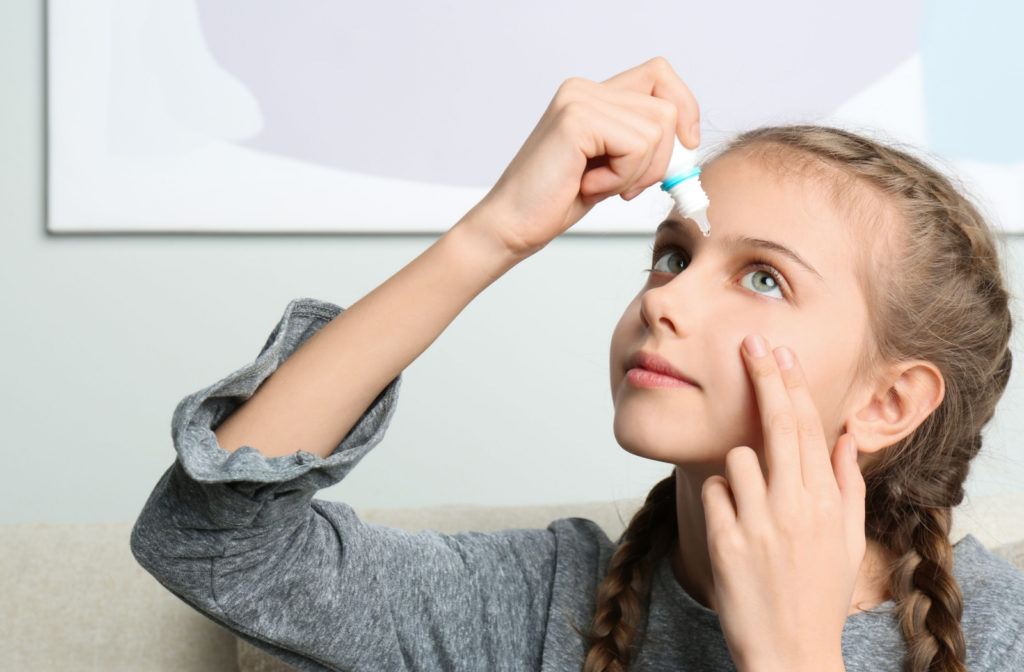Eye exams are essential for everyone to maintain their eye health, however, for children, regular eye exams, especially as they grow in a learning environment, are vital for supporting their healthy growth and development.
If your child suffers from dry eye syndrome, a lazy eye, or early onset myopia, they may require eye drops. And while kids can use eye drops, not all eye drops are the same, and not all eye drops are safe for children to use.
Let’s dive in to learn more about eye drops and their uses for children.
Are Eye Drops Safe for Kids?
Generally, eye drops are safe for children, if only to wet the eyes or cure particular eye problems. However, few studies determine if medicated eye drops are safe and effective for children. The best action is to ask your child’s eye doctor for a recommendation based on what brings you into the optometrist’s office.
What Are Children’s Eye Drops Used For?
Eye drops are frequently provided or prescribed by eye doctors for several reasons, even for children. The most common reasons are as follows:
- Dilation of the pupil
- Focusing lens relaxation
- Treating dry eyes or allergies
- Treatment of amblyopia (lazy eye)
- Managing the progression of myopia
Dilation of the Eye
A comprehensive eye exam for children includes a thorough evaluation of your child’s eyesight and ocular health and may include eye drops to expand their pupils. Pupil dilation allows for a clear view of the inner eye and its tissue, including the lens, vitreous, and retina, which is required for detecting ocular disease.
Does Eye Dilation Hurt?
Eye dilation drops do not hurt, though there may be a stinging sensation for seconds. This is normal and will subside.
Can Dilation Drops Affect Children’s Eyesight?
Even with drops in their eyes, your child can see. However, vision may be blurry for several hours. The drops primarily impair near vision rather than farsighted vision.
Your child’s eyes may become more vulnerable to light following the drops, and sensitivity can last up to 48 hours. If your child is light sensitive, ensure they wear protection, such as sunglasses, when outside or in bright environments.
Relaxing the Focusing Lens
The pupil needs to be dilated for accurate measurements during a refractive exam. There are eye drops for relaxing the lens to make measuring easier. These can be especially helpful for children who may be nervous during their exams.
Dry Eye Syndrome & Eye Drops
With more use of technology at younger and younger ages, dry eye syndrome in children is becoming more prevalent. Long-term use of technology can lower our blink rate, which causes tears to evaporate more quickly, leading to symptoms of dry eye.
The good news is that dry eye symptoms ease with reduced technology usage, and many children can find alleviation from their symptoms if they apply eye drops daily and make some simple lifestyle modifications.
Eye Drops for Allergies
Itchy eyes, weepy eyes, redness, discharge, and burning caused by allergies can often be relieved with eye drops. Children can use artificial tears for allergies as they do not include medication, making them safe.
Other eye drops that help relieve allergy symptoms are:
- Antihistamines: These medications provide temporary relief.
- Mast cell stabilizers: These work similarly to antihistamines but provide longer-lasting relief.
- Decongestants: Found in several over-the-counter eye drops, including those that reduce redness.
- Prescription corticosteroids: Often prescribed to help with severe or chronic pain.
Not all allergy treatments are safe for kids of all ages, so it’s important to consult with your doctor and follow their recommendations for treatment.
Eye Drops for Lazy Eye Treatment
Having a lazy eye is like having a bad roommate; they don’t pull their weight making for an unequal partnership. Luckily, there are eye drops specifically designed for lazy eye treatment!
Eye drops are often combined with visual therapy to treat your child’s lazy eye. To encourage the lazy eye to work, atropine drops are applied, which results in the unaffected eye becoming blurry for some time. This can help strengthen the eye-brain connection in the lazy eye.
Myopia Management with Eye Drops
Another use for eye drops is for myopia (nearsightedness) management, which is a condition where those affected can see objects that are close up, but further away objects are blurry.
Low-dose atropine eye drops for myopia control should be used at night and only once each night to avoid the side effects of sensitivity to light and blurred close-up vision. These side effects are due to the eye drops dilating the pupils once applied.
Start with an Eye Exam
As with any new medication in your child’s life, speaking with an expert is the first step.
The optometrists at Crum Optometry Group are experienced in working with children and their families, and making sure the experience is comfortable and fun for kids. Book an appointment and speak to our team to find out if eye drops are right for your child.






